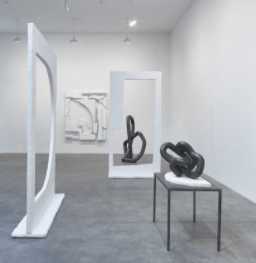
Installation view: “Carolyn Salas,” Koenig & Clinton, 2015. Courtesy the artist and Koenig & Clinton. Photo: Jeffry Sturges.
THE BROOKLYN RAIL
CAROLYN SALAS
JUL-AUG 2015
By Mary Proenza
The understated, abstract sculptures in Carolyn Salas’s first solo show at Koenig & Clinton are imbued with a lively formalism. The ten new, human-scale pieces are just right for the size of the gallery, and their thoughtful arrangement facilitates a sense of conversation between and within the individual objects. Five are painted white, resemble both plaster and Styrofoam, and are planar, including two wall reliefs and three doorway-like Cut Outs. Through these, you catch glimpses of the other, complementary sculptures, which coil in forms suggesting the human body or drawn lines. They look like lead, but aren’t. Salas has a talent for making one material look like another, and for the works on view she primarily employed Hydrocal, which is like a cross between plaster and cement, and Aqua-Resin, a non-toxic product commonly used for casting and molding.
The sculptures are particularly enlivened by the various and sometimes contradictory sensations they prompt. Cut Out (No. 1), (2015), which is over eight feet tall and made of Hydrocal, fiberglass, and steel armature, has an opening shaped like a giant capital “D.” It resembles an architectural arch set on its side, but the impulse to walk through it is checked by the reality that the opening doesn’t reach the ground. And so perception of the work shifts to something more like a big minimalist painting. The “D”-like image recalls Ellsworth Kelly, and the width of the big plane is that of stretcher bars. There’s an effective disjunction in the way this three-dimensional, freestanding work takes on the negative and positive space of two-dimensional art. The fact that the sculpture looks, all at once, like plaster, cement, and Styrofoam also sets off opposing associations. Where the surface crumbles like ancient plaster, the piece seems like a noble survivor from, say, Pompeii. Areas bearing the signature striations of modern cement walls suggest Brutalist buildings. But the sculpture can’t support either of those (or other possible) senses of history, or any real weight, when inevitably viewed as Styrofoam. You can’t miss the hallmark little pills, and in fact all of the white sculptures were cast from Styrofoam, which lends the piece a hellishly enduring yet flimsy and impressionable quality. Cut Out (No. 1) even bears the subtle stamp of one of those steel plates embossed with an anti-slip “X”-like pattern that often line sidewalks, as if authenticating the material as real Styrofoam found pressed by other trash onto the street.
In Untitled (No. 11) (2015), part of the sculpture is a wall relief, in which two half-circles have been cut from two rectangles, which overlap to form a whole circle. The other part is a tall, thin, jagged segment that stands on the floor and is propped against the wall relief. If it weren’t for the propped piece, the work would read like a bona fide minimal artwork from circa 1960—one that couldn’t possibly be made of foam. Yet the leaning piece shifts attention back to the Styrofoam aspect and adds an incidental quality, as if the materials had been spit out by the ocean onto a beach or by a consumer onto the sidewalk and then someone happened to arrange some of the parts as art.
Stryofoam, the ubiquitous material for packing consumer products and known for its inability to decompose, is loaded with connotations. In using it, Salas touches upon issues of consumerism and the environment. But her strongest statement with Styrofoam has to do with expectations or contradictions of weight.
In Movement Studies (Nos. 3 and 4) (both 2015), the visually leaden sculptures sit on Styrofoam-like bases, signaling responses like, “Can’t support!” As her other works inspire, when one possible reading meets a roadblock, another springs up. In part because these pieces attain their lead-likeness from their graphite powder coating, they’re like pencil-drawn lines, which makes them read as weightless. The “movements” they “study” could be the gestures of figures in sketches. In their reference to drawing, they suggest how works of art germinate—and that the germination is the art. Like drawings, the sculptures are unmistakably of the hand, especially in their lustrous finish, which is lovingly drawn to a polish with graphite.
This is an elegant, cohesive set of sculptures, and the show is only Salas’s second New York solo exhibition. It’ll be good to see what she goes on to do. Her sculptures have a restrained beauty that’s clearly felt and are wonderful in their suggestive powers.